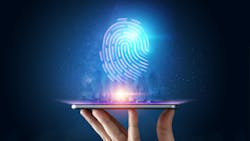Biometrics in dentistry: Uses, benefits, and cautions
Perhaps you open your cell phone by the use of facial recognition? Or maybe your child paid for their school lunch by placing their fingerprint on a pad to deduct funds from their account? By doing these simple, everyday acts, we are using biometrics.
What is biometric identification?
Biometric identification (BI) is a form of identification that uses artificial intelligence. BI describes human body traits that are measured and calculated to help identify a person. These identifying traits are unique and measurable. Examples of BI include fingerprints, palm veins, palm prints, facial recognition, iris recognition, retina recognition, and the shape of ears. According to Statista, “In 2022, the digital identity solutions market—of which biometric technology is a major component—was valued at 28 billion US dollars with a forecast exceeding 70 billion US dollars by 2027.”1
Also by the author … Oral hygiene instruction: Do your patients understand its importance?
How biometrics can benefit dentistry
It is projected that in the upcoming year, more and more dental offices will begin to use BI to help with security issues in their offices. The hope is that BI will help with patient confidentiality and streamline administrative processes.2
Biometric dentistry is gaining in popularity as more dental offices become almost completely paperless in the digital era.3,4 Biometric dentistry uses unique human characteristics to access parts of the electronic health record such as health history documentation.3-5 Dental BI has also been used in radiographs,6 and it can help odontologists in forensic dentistry as unique BI, such as bite molds and lip prints, can be used to identify and/or confirm identity of a corpse.7
As a dental professional, BI may help with the flow of the appointment if a patient can simply press their finger on a scanner and access their digital scans, radiographs, medical history paperwork, and dental chart. Aside from the convenience, some professionals say BI not only helps reduce paper, but it can prevent serious issues such as patient misidentification, insurance fraud, and breaches of patient privacy.5
Sometimes several patients in a dental practice may have the same name, or, even worse, they may be scheduled for visits at the same time. By using unique personal BI, dental providers don’t have to worry about mistaking a patient for another with the same name. Insurance fraud would potentially be reduced if a dental practice was using dental BI. Because everyone’s biometric characteristics are so unique, they help confirm that dental charts and insurance claims are not mistaken with another patient’s information. Some computer science professionals believe BI helps protect patient privacy, because if someone were to hack into an electronic health record, the BI would appear as useless computer codes, making patient data less enticing to online identity thieves.
Cautions and concerns about using BI in dentistry
Despite some advocating for greater use of dental BI, others argue that BI is too new and still far too advanced for dental providers to use it in day-to-day operations. The biggest concerns about the use of BI are security breaches, cost, and skepticism. As with any new technological advancement, there is a learning curve and required training.
Also by the author … Chlorhexidine mouthwash: Still the best choice for dental patients?
Both the ADA and other researchers have studied the hesitation some dental providers have about introducing BI into their practices.8 Many dentists who do not wish to update their offices with more technology cite costs and not recognizing the value of BI as some of the greatest limitations.4,9
Does BI violate HIPAA?
In addition to skepticism, the biggest area of concern dental providers must address is whether BI runs the risk of violating HIPAA. BI is considered identifying data that could be linked to each patient, so it does fall under the category of protected health information (PHI).9 Because of this highly sensitive data, a dental office using any form of BI, whether in clerical or clinical aspects, must make sure that proper safeguards are in place.
Safeguards first came out in 2009 and were constructed to help keep health-care workers’ fingerprints from being compromised by hackers. The Health Information Technology for Economic Clinical Health Act (HITECH Act) included laws specifically designed to help employers who were collecting any sort of BI data—whether on their patients or employees—understand the rules and regulations about how any BI would be collected, stored, and destroyed.9
Biometrics in dentistry: A look to the future
In the future, perhaps we could see BI used even more in dentistry. For example, dental professionals could use biometrics to access credentialing documents, such as provider licensure, national provider identification number, and continuing education credits.
Biometrics, when properly safeguarded, can help dental practices run more efficiently. Although once used only in hospitals, biometrics is starting to have more uses throughout the dental appointment. Dental professionals should be on the lookout to see greater use of biometrics in the future.
Editor’s note: This article first appeared in Clinical Insights newsletter, a publication of the Endeavor Business Media Dental Group. Read more articles and subscribe.
References
- Biometric technologies – statistics & facts. Statista. January 10, 2024. Accessed January 21, 2024. https://www.statista.com/topics/4989/biometric-technologies/#topicOverview
- Dental trends 2024: what’s hot in oral care this year. Dental 360. December 14, 2023. https://dental360usa.com/2023/12/dental-trends-2024-whats-hot-in-oral-care-this-year/
- Vandenberghe B. The digital patient – imaging science in dentistry. J Dent. 2018;74(1):S21-S26. doi:10.1016/j.jdent.2018.04.019
- Acharya A, Schroeder D, Schwei K, Chyou PH. Update on electronic dental record and clinical computing adoption among dental practices in the United States. Clin Med Res. 2017;15(3-4):59-74. doi:10.3121/cmr.2017.1380
- Murad M. Why healthcare facilities should adopt biometrics. Campus Safety. April 25, 2022. https://www.campussafetymagazine.com/news/why-healthcare-facilities-should-adopt-biometrics/
- Ajaz A, Kathirvelu D. Dental biometrics: Computer aided human identification system using the dental panoramic radiographs. Presented at: 2013 International Conference on Communication and Signal Processing; April 3-5, 2013; Melmaruvathur, India. pp. 717-721. doi:10.1109/iccsp.2013.6577149
- Kaul B, Vaid V, Gupta S, Kaul S. Forensic odontological parameters as biometric tool: a review. Int J Clin Pediatr Dent. 2021;14(3):416-419. doi:10.5005/jp-journals-10005-1967
- Burger D. ADA conducting survey to understand use, interoperability of electronic health and dental records. ADA News. May 01, 2023. https://adanews.ada.org/ada-news/2023/april/ada-conducting-survey-to-understand-use-interoperability-of-electronic-health-and-dental-records/
- Rajaee L. Is biometric data a HIPAA risk? Elation. February 19, 2020. https://www.elationhealth.com/resources/blogs/is-biometric-data-a-hipaa-risk
Tracee S. Dahm, MS, BSDH, RDH, is an adjunct clinical instructor for the North Idaho College School of Dental Hygiene in Coeur d’Alene, Idaho. Tracee also works in private practice. Her research interests include trends in dental hygiene and improving access to dental care for the underserved. She can be reached at [email protected].
About the Author
Tracee S. Dahm, MS, BSDH, RDH
Tracee S. Dahm, MS, BSDH, RDH, is an adjunct clinical instructor for the North Idaho College School of Dental Hygiene in Coeur d’Alene, Idaho, and she also works in private practice. She has been published in several dental journals, magazines, webinars, and textbooks. Tracee is a key opinion leader on cutting-edge innovations in the hygiene field. Her research interests include trends in dental hygiene, improving access to dental care for the underserved, and mental health. Contact her at [email protected].

